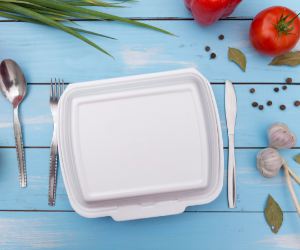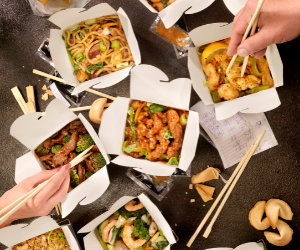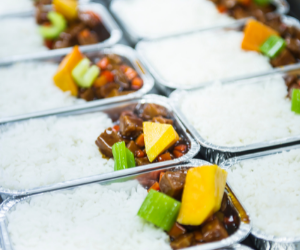“Can you put take out containers in the microwave?” or “Is this container safe for hot foods?” are questions you may oftentimes ask yourself when packaging take out orders. The answers to these questions will help you understand which materials should be used when packing certain types of foods to eliminate messy accidents during transport. Instead of having to constantly look up which container materials are appropriate for your meals, you can use our guide to help you decide what type of container is best for each dish.
Plastic
Known for being rigid and leak-resistant, plastic containers are extremely durable. They can take a few bumps in the road while still keeping your meals protected and intact. Great for hefty meals like pasta or rice dishes, this material can hold the weight of large to-go orders. However, not all plastic containers can endure the same temperatures.
Polyethylene Terephthalate (PET)
PET containers are often clear, durable, and not easily punctured, which means they can protect your foods from outside contamination. These take out boxes are also recyclable if disposed of properly. When exposed to high temperatures, food-safe PET can leach the contaminant, antimony, into your foods. On the other hand, cold foods such as salads and wraps can be packaged and stored into PET containers.
PET Temperature Limits:
- Up to 120°F
Use PET containers for:
- Packaging cold foods
- Storing meals in the fridge or freezer
Polypropylene (PP)
Used in the foodservice and healthcare industry, PP containers are considered to be very strong and can resist impact, making them ideal for transporting or customers that are on the go. Like most plastics, this material is recyclable, leak-resistant, and sturdy. Their strength makes them ideal to withstand hot and cold temperatures so you can package a variety of meals.
PP Temperature Limits:
- Minimum temperatures: -4°F to 14°F
- Maximum temperatures: 212°F to 266°F
Use PP containers for:
- Packaging hot and cold foods
- Reheating meals in the microwave
- Storing meals in the fridge or freezer
Polylactic Acid (PLA)
Eco-friendly and sustainable, PLA plastic containers are made from renewable sources, like cornstarch, sugarcane, and other plants. Derived from natural resources, this type of container is commercially compostable and biodegradable. The disadvantage of this material is that it can easily melt in high temperatures and should therefore not be left inside of a car on a hot day.
PLA Temperature Limits:
- Up to 140°F
Use PLA containers for:
- Packaging cold foods
Bagasse
Made from sugarcane pulp, bagasse is commercially compostable and biodegradable, making it the perfect option for eco-friendly restaurants. It is naturally grease-resistant and can retain the heat of your meals to a certain extent. This eco-friendly food packaging material can withstand a wide range of temperatures so you can package any type of meal.
Bagasse Temperature Limits:
- Around -13°F to 428°F
Use Bagasse containers for:
- Packaging hot and cold foods
- Reheating meals in the microwave
- Storing meals in the fridge or freezer
 Foam
Foam
Foam containers or polystyrene foam are used as vessels for take out containers, drinks, and retail packaging. They are lightweight and fairly sturdy and can be torn if not handled properly. The downside to these is that they are very harmful to the environment and are not accepted by curbside recycling programs because they are often contaminated with food, making them difficult to clean. Because they are harmful to the environment, an increasing amount of cities and states, such as San Francisco and New York, have banned foam containers or are in the process of banning them.
Use foam containers for:
- Storing meals in the fridge
 Paper
Paper
Many operators like to choose paper containers because they are available in a variety of colors that match the color scheme of their establishment. Some paper take out containers for restaurants even have a grease-resistant lining to prevent oils from soaking through and creating a mess. They retain heat fairly well but don’t expect paper containers to keep your food warm for an extended period of time. However, most are recyclable and eco-friendly. When using paper containers, check to see if they are microwave-safe. For example, paper containers with a PP liner are microwave-safe, but paper containers with a PE liner are not.
Paper Temperature Limits:
- Temperature limits depend on the type of plastic lining. Ask your vendor about your product’s temperature limit.
Use paper containers for:
- Packaging hot foods
- Reheating meals in the microwave (if microwave-safe)
 Aluminum
Aluminum
Aluminum containers allow prepacked entrees to be reheated in the oven and are typically used for packaging a large amount of food for take out or catering events. These containers are preferred by caterers because they find it convenient to cook dishes in the oven and simply take them out for serving all in the same vessel. Plus, they’re grease-resistant and flexible, making them great for holding hefty dishes.
Aluminum Temperature Limits:
- -20°F to 400°F
Use aluminum containers for:
- Baking dishes in the oven
- Storing meals in the fridge or freezer
- Packaging hot and cold foods








